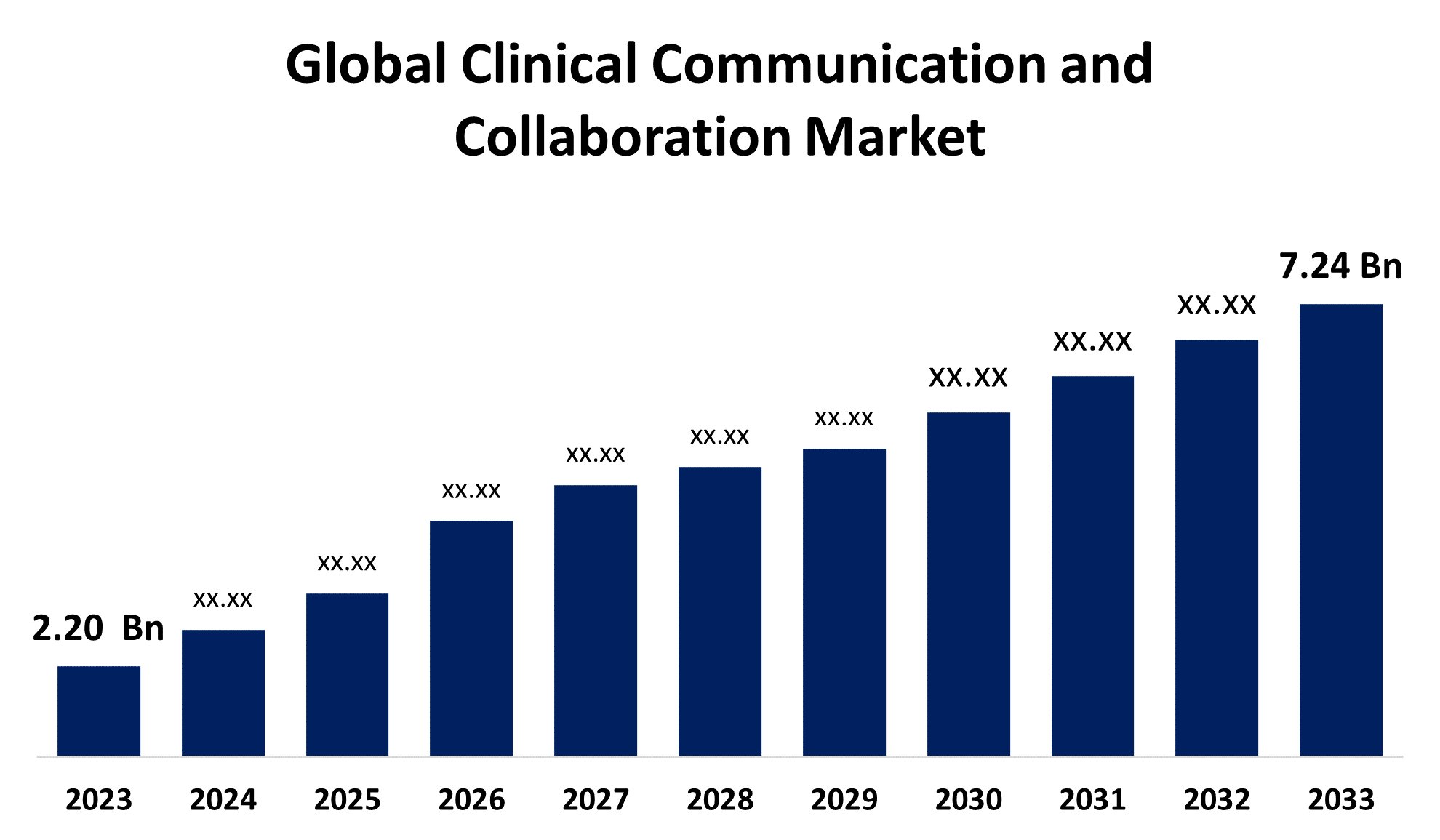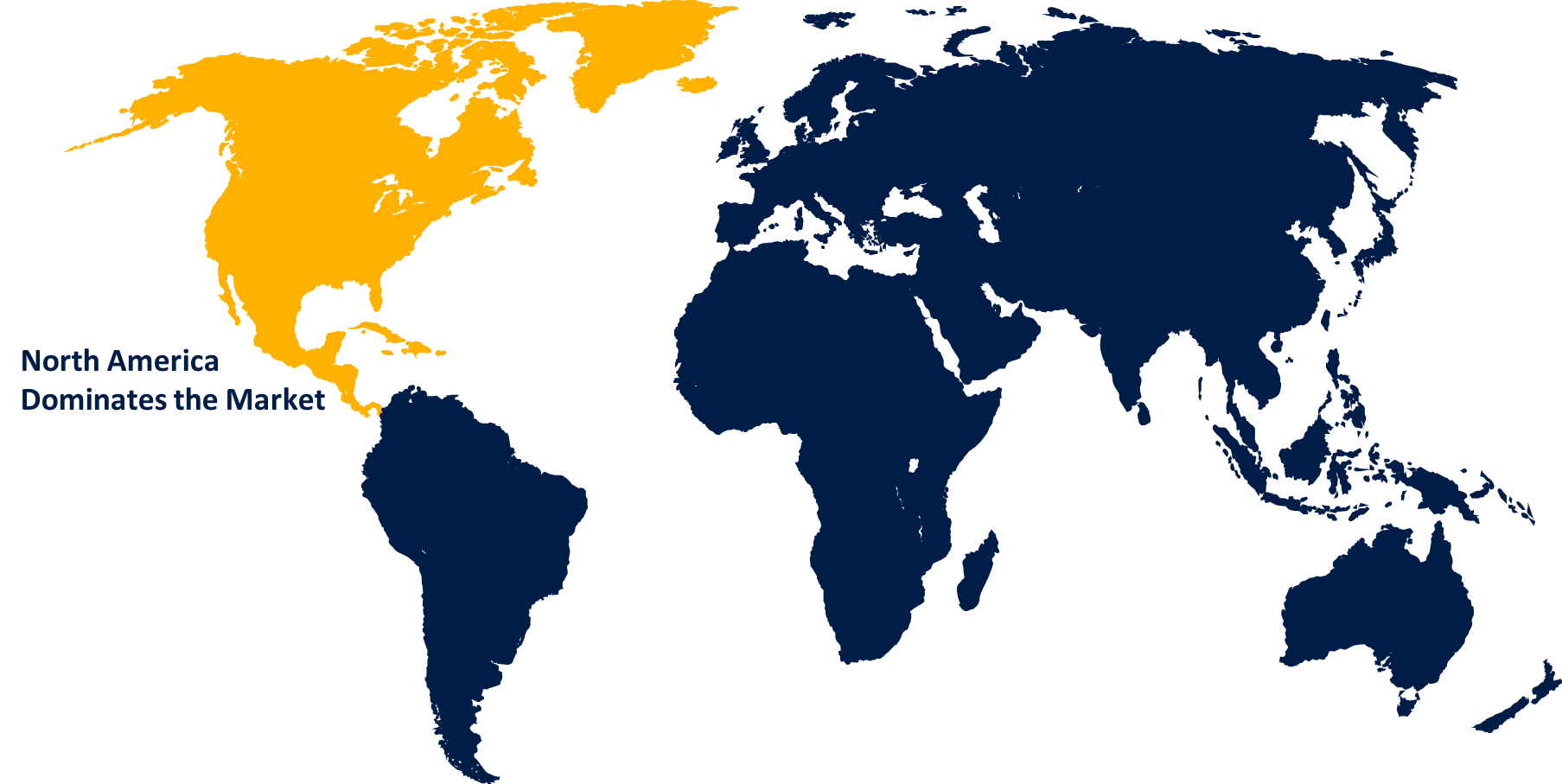Global Clinical Communication and Collaboration Market Size, Share, and COVID-19 Impact Analysis, By Component (Solution and Services), By Deployment (Hosted and On-Premise), By End-Use (Hospitals, Clinical Labs, Physicians, and Others), and By Region (North America, Europe, Asia-Pacific, Latin America, Middle East, and Africa), Analysis and Forecast 2023 - 2033
Industry: HealthcareGlobal Clinical Communication and Collaboration Market Insights Forecasts to 2033
- The Global Clinical Communication and Collaboration Market Size was Valued at USD 2.20 Billion in 2023
- The Market Size is Growing at a CAGR of 12.65% from 2023 to 2033
- The Worldwide Clinical Communication and Collaboration Market Size is Expected to Reach USD 7.24 Billion by 2033
- Asia-Pacific is Expected to Grow the fastest during the forecast period.

Get more details on this report -
The Global Clinical Communication and Collaboration Market Size is Anticipated to Exceed USD 7.24 Billion by 2033, Growing at a CAGR of 12.65% from 2023 to 2033.
Market Overview
Clinical communication and collaboration (CC&C) are secure messaging solutions that integrate with clinical systems to strengthen the workflow for physicians, nurses, and other care team members from a smartphone or desktop application. It is an evolution from secure messaging solutions that focus on texting in a HIPAA-compliant manner. It delivers secure and stable access to critical information even when downtime occurs, and also provides all users with the tools to communicate across the care continuum. As healthcare systems become increasingly complex with growing concerns about security threats and cyberattacks on standard methods of communication, and the risk of hacking patient’s data, providers must continuously strive to improve communication and collaboration. Leading CC&C platforms provide a range of functionalities, including alarm management, event notification, patient engagement, scheduling, and message security. The ability to automatically erase messages or wipe equipment is quite beneficial, considering the increasing hostile attacks against healthcare companies. This type of system helps build collaborative care plans by empowering primary care physicians, surgeons, and specialists to add their input. It can also help reduce costs, improve revenue, and enhance patient and provider satisfaction. With increased safety and streamlined efficiency comes improved patient outcomes, making this technology essential for protecting data and providing better care in the ever-evolving digital age.
Report Coverage
This research report categorizes the market for the global clinical communication and collaboration market based on various segments and regions forecasts revenue growth and analyzes trends in each submarket. The report analyses the key growth drivers, opportunities, and challenges influencing the global clinical communication and collaboration market. Recent market developments and competitive strategies such as expansion, product launch, and development, partnership, merger, and acquisition have been included to draw the competitive landscape in the market. The report strategically identifies and profiles the key market players and analyses their core competencies in each sub-segment of the global clinical communication and collaboration market.
Clinical Communication and Collaboration Market Report Coverage
| Report Coverage | Details |
|---|---|
| Base Year: | 2023 |
| Market Size in 2023: | USD 2.20 Billion |
| Forecast Period: | 2023-2033 |
| Forecast Period CAGR 2023-2033 : | 12.65% |
| 2033 Value Projection: | USD 7.24 Billion |
| Historical Data for: | 2019-2022 |
| No. of Pages: | 200 |
| Tables, Charts & Figures: | 110 |
| Segments covered: | By Component, By Deployment, By End-Use, By Region |
| Companies covered:: | Cisco Systems, Inc., Avaya LLC, Oracle, NEC Corporation, Microsoft Corporation, Intel Corporation, Vocera Communications, Plantronics, Inc., Intel Corporation, TNS Inc. (AGNITY Inc.), Halo Health Systems, Baxter International (Hillrom), Spok Holdings Inc., TigerConnect, JCT Healthcare Pty Ltd., Ascom Holding AG, Others, Cisco Systems, Inc., Avaya LLC, Oracle, NEC Corporation, Microsoft Corporation, Intel Corporation, Vocera Communications, Plantronics, Inc., Intel Corporation, TNS Inc. (AGNITY Inc.), Halo Health Systems, Baxter International (Hillrom), Spok Holdings Inc., TigerConnect, JCT Healthcare Pty Ltd., Ascom Holding AG, and Others Key Vendors. |
| Pitfalls & Challenges: | COVID-19 Empact, Challenges, Future, Growth, & Analysis |
Get more details on this report -
Driving Factors
The growing emphasis on enhanced patient care and safety surges the market demand for clinical communication and collaborations. Further, technological advancements for effective communication and the growing demand for real-time communication and secure messaging are responsible for driving the market. The use of smart devices for clinical communication and the rising popularity of collaboration solutions are also driving market growth. The use of AI in telemedicine contributes to enhancing healthcare services including teleradiology, telepathology, and teledermatology. Further, the increasing use of cloud-based software for sharing, collaborating, and communicating with all locations in real-time creates lucrative market growth opportunities.
Restraining Factors
The regulatory compliance complexity and the lack of standardized communication protocols and interoperability are restraining the global clinical communication and collaboration market. Further, the high maintenance cost of of on-premises deployments is considered to restrain the market growth. The shortage of trained personnel for operating highly complex technologies like flow cytometers and spectrophotometers impeding the market demand.
Market Segmentation
The global clinical communication and collaboration market share is classified into component, deployment, and end-use.
- The solution segment is expected to hold the largest share of the global clinical communication and collaboration market during the forecast period.
Based on the component, the global clinical communication and collaboration market is categorized into solution and services . Among these, the solution segment is expected to hold the largest share of the global clinical communication and collaboration market during the forecast period. The clinical communication and collaboration facilitate real-time data sharing, capture alarms, and notifications, and optimize care transitions that contribute more toward patient safety and satisfaction. It provides immediate responses during crisis management.
- The on-premise segment dominates the market with the largest revenue share through the forecast period.
Based on the deployment, the global clinical communication and collaboration market is categorized into hosted and on-premise. Among these, the on-premise segment dominates the market with the largest revenue share through the forecast period. The rising preference for on-premise due to better control over infrastructure and sensitive healthcare data (physical data centers). It permits more integration and customization with additional software and systems according to the demand of the company. It is more convenient and cost-effective for larger organizations with long-term commitment to the software and have invested in IT infrastructure.
- The hospital segment is expected to grow at the fastest CAGR during the forecast period.
Based on the end-use, the global clinical communication and collaboration market is categorized into hospitals, clinical labs, physicians, and others. Among these, the hospital segment is expected to grow at the fastest CAGR during the forecast period. A report by the Joint Commission states that 70% of medical errors are attributed to communication breakdowns. Thus, there is a need for efficient communication and coordination in the hospital segment. These clinical systems are becoming more common in healthcare workers’ daily lives due to technological advancements and rising smartphone penetration. These collaboration systems make patient health information and treatment schedules accessible and available to all legitimate stakeholders and systems.
Regional Segment Analysis of the Global Clinical Communication and Collaboration Market
- North America (U.S., Canada, Mexico)
- Europe (Germany, France, U.K., Italy, Spain, Rest of Europe)
- Asia-Pacific (China, Japan, India, Rest of APAC)
- South America (Brazil and the Rest of South America)
- The Middle East and Africa (UAE, South Africa, Rest of MEA)
North America is anticipated to hold the largest share of the global clinical communication and collaboration market over the predicted timeframe.

Get more details on this report -
North America is projected to hold the largest share of the global clinical communication and collaboration market over the forecast period. With the rising healthcare spending, most hospitals in the US have implemented clinical communication and collaboration. For instance, the implementation of the collaboration tool Columbia County Health System provides a real-time conversation. Further, the presence of significant key players is also responsible for enhancing the market growth in the region.
Asia-Pacific is expected to grow at the fastest CAGR growth of the global clinical communication and collaboration market during the forecast period. The COVID outbreak has surged the use of telemedicine platforms in the region. Further, the growing population, rising disposable income, and improving economic scenario will drive the growth of the market in the region. With the support of the government, there is growing use of telemedicine platforms on a large scale is anticipated to fuel the market growth.
Competitive Analysis:
The report offers the appropriate analysis of the key organizations/companies involved within the global clinical communication and collaboration market along with a comparative evaluation primarily based on their product offering, business overviews, geographic presence, enterprise strategies, segment market share, and SWOT analysis. The report also provides an elaborative analysis focusing on the current news and developments of the companies, which includes product development, innovations, joint ventures, partnerships, mergers & acquisitions, strategic alliances, and others. This allows for the evaluation of the overall competition within the market.
List of Key Companies
- Cisco Systems, Inc.
- Avaya LLC
- Oracle
- NEC Corporation
- Microsoft Corporation
- Intel Corporation
- Vocera Communications
- Plantronics, Inc.
- Intel Corporation
- TNS Inc. (AGNITY Inc.)
- Halo Health Systems
- Baxter International (Hillrom)
- Spok Holdings Inc.
- TigerConnect
- JCT Healthcare Pty Ltd.
- Ascom Holding AG
- Others
Key Target Audience
- Market Players
- Investors
- End-users
- Government Authorities
- Consulting And Research Firm
- Venture capitalists
- Value-Added Resellers (VARs)
Recent Developments
- In August 2023, TigerConnect, healthcare’s most trusted clinical collaboration platform, announced its Physician Scheduling solution’s inclusion on the KLAS Research list of validated vendors in their Physician Scheduling category.
- In April 2023, Mobile Heartbeat, the leading clinical communication and collaboration company, announced a partnership with Akkadian Labs, developer of the leading unified communications (UC) provisioning automation solution for enterprises and MSPs. MH-CURE, their flagship product integrated with Akkadian Provisioning Manager allowing zero-touch provisioning for users.
- In January 2023, Royal Philips, a global leader in health technology, and Masimo, a global medical technology company, announced an expansion of their partnership to augment patient monitoring capabilities in home telehealth applications with the Masimo W1 advanced health tracking watch.
Market Segment
This study forecasts revenue at global, regional, and country levels from 2020 to 2033. Spherical Insights has segmented the global clinical communication and collaboration market based on the below-mentioned segments:
Global Clinical Communication and Collaboration Market, By Component
- Solution
- Services
Global Clinical Communication and Collaboration Market, By Deployment
- Hosted
- On-Premise
Global Clinical Communication and Collaboration Market, By End-Use
- Hospitals
- Clinical Labs
- Physicians
- Others
Global Clinical Communication and Collaboration Market, Regional Analysis
- North America
- US
- Canada
- Mexico
- Europe
- Germany
- Uk
- France
- Italy
- Spain
- Russia
- Rest of Europe
- Asia Pacific
- China
- Japan
- India
- South Korea
- Australia
- Rest of Asia Pacific
- South America
- Brazil
- Argentina
- Rest of South America
- Middle East & Africa
- UAE
- Saudi Arabia
- Qatar
- South Africa
- Rest of the Middle East & Africa
Frequently Asked Questions (FAQ)
-
1.What is the CAGR of the global clinical communication and collaboration market over the forecast period?The global clinical communication and collaboration market is projected to expand at a CAGR of 12.65% during the forecast period.
-
2.What is the projected market size & growth rate of the global clinical communication and collaboration market?The global clinical communication and collaboration market was valued at USD 2.20 Billion in 2023 and is projected to reach USD 7.24 Billion by 2033, growing at a CAGR of 12.65% from 2023 to 2033.
-
3.Which region is expected to hold the highest share in the global clinical communication and collaboration market?The North America region is expected to hold the highest share of the global clinical communication and collaboration market.
Need help to buy this report?